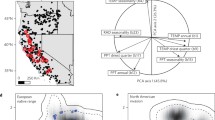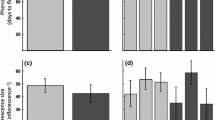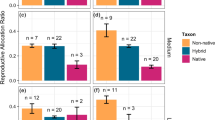Abstract
Species invading new habitats experience novel selection pressures that can lead to rapid evolution, which may contribute to invasion success and/or increased impact on native community members. Many studies have hypothesized that plants in the introduced range will be larger than those in the native range, leading to increases in competitive ability. There is mixed support for evolution of larger sizes in the introduced range, but few studies have explicitly tested whether evolutionary changes result in decreased competitive responses or increased competitive effects on other species in the community. Here, we show that introduced Medicago polymorpha genotypes produced 14% more aboveground and 41% more belowground biomass than genotypes from the native range, suggesting that evolutionary changes in size occurred after introduction. However, these size differences were only observed in the absence of competition. The competitive effects of introduced and native range genotypes on three species that commonly co-occur with Medicago in invaded regions were remarkably similar. These results suggest that evolutionary increases in size during biological invasions do not necessarily alter the competitive effects of the invader on other community members, but may increase invasion success in disturbed or low competition environments.


Similar content being viewed by others
References
Atwood JP, Meyerson LA (2011) Beyond EICA: understanding post-establishment evolution requires a broader evaluation of potential selection pressures. NeoBiota 10:7–25. https://doi.org/10.3897/neobiota.10.954
Baker HG (1974) The evolution of weeds. Ecol Evol Syst 5:1–24
Bayliss SLJ, terHorst CP, Lau JA (2017) Testing genotypic variation of an invasive plant species in response to soil disturbance and herbivory. Oecologia 183:1135–1141. https://doi.org/10.1007/s00442-017-3820-9
Beaton LL, Van Zandt PA, Esselman EJ, Knight TM (2011) Comparison of the herbivore defense and competitive ability of ancestral and modern genotypes of an invasive plant, Lespedeza cuneata. Oikos 120:1413–1419. https://doi.org/10.1111/j.1600-0706.2011.18893.x
Blossey B, Notzold R (1995) Evolution of increased competitive ability in invasive nonindigenous plants: a hypothesis. J Ecol 83:887–889. https://doi.org/10.2307/2261425
Blumenthal DM (2006) Interactions between resource availability and enemy release in plant invasion. Ecol Lett 9:887–895. https://doi.org/10.1111/j.1461-0248.2006.00934.x
Blumenthal DM, Hufbauer RA (2007) Increased plant size in exotic populations: a common-garden test with 14 invasive species. Ecology 88:2758–2765. https://doi.org/10.1890/06-2115.1
Bossdorf O, Prati D, Auge H, Schmid B (2004) Reduced competitive ability in an invasive plant. Ecol Lett 7:346–353. https://doi.org/10.1111/j.1461-0248.2004.00583.x
Buswell JM, Moles AT, Hartley S (2011) Is rapid evolution common in introduced plant species? J Ecol 99:214–224. https://doi.org/10.1111/j.1365-2745.2010.01759.x
Catford JA, Jansson R, Nilsson C (2009) Reducing redundancy in invasion ecology by integrating hypotheses into a single theoretical framework. Divers Distrib 15:22–40. https://doi.org/10.1111/j.1472-4642.2008.00521.x
Colautti RI, Barrett SCH (2013) Rapid adaptation to climate facilitates range expansion of an invasive plant. Science 342:364–366. https://doi.org/10.1126/science.1242121
Colautti RI, Lau JA (2015) Contemporary evolution during invasion: evidence for differentiation, natural selection, and local adaptation. Mol Ecol 24:1999–2017. https://doi.org/10.1111/mec.13162
Colautti RI, Maron JL, Barrett SCH (2009) Common garden comparisons of native and introduced plant populations: latitudinal clines can obscure evolutionary inferences. Evol Appl 2:187–199. https://doi.org/10.1111/j.1752-4571.2008.00053.x
Dlugosch KM, Parker IM (2008) Founding events in species invasions: genetic variation, adaptive evolution, and the role of multiple introductions. Mol Ecol 17:431–449. https://doi.org/10.1111/j.1365-294X.2007.03538.x
Dostal P, Allan E, Dawson W et al (2013) Enemy damage of exotic plant species is similar to that of natives and increases with productivity. J Ecol 101:388–399. https://doi.org/10.1111/1365-2745.12037
Ebeling SK, Welk E, Auge H, Bruelheide H (2008) Predicting the spread of an invasive plant: combining experiments and ecological niche model. Ecography 31:709–719. https://doi.org/10.1111/j.1600-0587.2008.05470.x
Ellner SP, Geber MA, Hairston NG (2011) Does rapid evolution matter? Measuring the rate of contemporary evolution and its impacts on ecological dynamics. Ecol Lett 14:603–614. https://doi.org/10.1111/j.1461-0248.2011.01616.x
Felker-Quinn E, Schweitzer JA, Bailey JK (2013) Meta-analysis reveals evolution in invasive plant species but little support for evolution of increased competitive ability (EICA). Ecol Evol 3:739–751. https://doi.org/10.1002/ece3.488
Firestone JL, Jasieniuk M (2013) Small population size limits reproduction in an invasive grass through both demography and genetics. Oecologia 172:109–117. https://doi.org/10.1007/s00442-012-2465-y
Goldberg D, Werner P (1983) Equivalence of competitors in plant communities: a null hypothesis and a field experimental approach. Am J Bot 70:1098–1104. https://doi.org/10.2307/2442821
Gonzalez-Teuber M, Quiroz CL, Concha-Bloomfield I, Cavieres LA (2017) Enhanced fitness and greater herbivore resistance: implications for dandelion invasion in an alpine habitat. Biol Invasions 19:647–653. https://doi.org/10.1007/s10530-016-1309-9
Gray A (1879) The pertinacity and predominance of weeds. Am J Sci 18:161–167
Hairston NG, Ellner SP, Geber MA et al (2005) Rapid evolution and the convergence of ecological and evolutionary time. Ecol Lett 8:1114–1127. https://doi.org/10.1111/j.1461-0248.2005.00812.x
Harper JL (1964) The individual in the population. J Ecol 52:149–159
He W-M, Feng Y, Ridenour WM et al (2009) Novel weapons and invasion: biogeographic differences in the competitive effects of Centaurea maculosa and its root exudate (±)-catechin. Oecologia 159:803–815. https://doi.org/10.1007/s00442-008-1234-4
Heady HF (1977) Valley grassland. In: Barbour MG, Major J (eds) Terrestrial vegetation of California. Wiley, New York, pp 491–514
Huang W, Carrillo J, Ding J, Siemann E (2012) Interactive effects of herbivory and competition intensity determine invasive plant performance. Oecologia 170:373–382. https://doi.org/10.1007/s00442-012-2328-6
Hufbauer RA, Facon B, Ravigne V et al (2012) Anthropogenically induced adaptation to invade (AIAI): contemporary adaptation to human-altered habitats within the native range can promote invasions. Evol Appl 5:89–101. https://doi.org/10.1111/j.1752-4571.2011.00211.x
Joshi S, Gruntman M, Bilton M et al (2014) A comprehensive test of evolutionarily increased competitive ability in a highly invasive plant species. Ann Bot 114:1761–1768. https://doi.org/10.1093/aob/mcu199
Lau JA (2008) Beyond the ecological: biological invasions alter natural selection on a native plant species. Ecology 89:1023–1031. https://doi.org/10.1890/06-1999.1
Lau JA, Strauss SY (2005) Insect herbivores drive important indirect effects of exotic plants on native communities. Ecology 86:2990–2997. https://doi.org/10.1890/04-1779
Leger EA, Rice KJ (2003) Invasive California poppies (Eschscholzia californica Cham.) grow larger than native individuals under reduced competition. Ecol Lett 6:257–264. https://doi.org/10.1046/j.1461-0248.2003.00423.x
Meyer GA, Hull-Sanders HM (2008) Altered patterns of growth, physiology and reproduction in invasive genotypes of Solidago gigantea (Asteraceae). Biol Invasions 10:303–317. https://doi.org/10.1007/s10530-007-9131-z
Miller T, Werner P (1987) Competitive effects and responses between plant species in a 1st-year old-field community. Ecology 68:1201–1210. https://doi.org/10.2307/1939204
Oduor AMO, Strauss SY, Garcia Y et al (2013) Herbivores mediate different competitive and facilitative responses of native and invader populations of Brassica nigra. Ecology 94:2288–2298. https://doi.org/10.1890/12-2021.1
Phillips BL, Brown GP, Shine R (2010) Evolutionarily accelerated invasions: the rate of dispersal evolves upwards during the range advance of cane toads. J Evol Biol 23:2595–2601. https://doi.org/10.1111/j.1420-9101.2010.02118.x
Ridenour WM, Vivanco JM, Feng Y et al (2008) No evidence for trade-offs: centaurea plants from America are better competitors and defenders. Ecol Monogr 78:369–386. https://doi.org/10.1890/06-1926.1
Roman J (2006) Diluting the founder effect: cryptic invasions expand a marine invader’s range. Proc R Soc B Biol Sci 273:2453–2459. https://doi.org/10.1098/rspb.2006.3597
Sakai AK, Allendorf FW, Holt JS et al (2001) The population biology of invasive species. Annu Rev Ecol Syst 32:305–332. https://doi.org/10.1146/annurev.ecolsys.32.081501.114037
Schenk HJ, Jackson RB (2002) Rooting depths, lateral root spreads and below-ground/above-ground allometries of plants in water-limited ecosystems. J Ecol 90:480–494. https://doi.org/10.1046/j.1365-2745.2002.00682.x
Sexton JP, McKay JK, Sala A (2002) Plasticity and genetic diversity may allow saltcedar to invade cold climates in North America. Ecol Appl 12:1652–1660. https://doi.org/10.2307/3099929
Shelby N, Hulme PE, van der Putten WH et al (2016) No difference in the competitive ability of introduced and native Trifolium provenances when grown with soil biota from their introduced and native ranges. Aob Plants 8:plw016. https://doi.org/10.1093/aobpla/plw016
Strauss SY, Lau JA, Schoener TW, Tiffin P (2008) Evolution in ecological field experiments: implications for effect size. Ecol Lett 11:199–207. https://doi.org/10.1111/j.1461-0248.2007.01128.x
terHorst CP, Lau JA (2012) Direct and indirect transgenerational effects alter plant-herbivore interactions. Evol Ecol 26:1469–1480. https://doi.org/10.1007/s10682-012-9560-8
terHorst CP, Lennon JT, Lau JA (2014) The relative importance of rapid evolution for plant-microbe interactions depends on ecological context. Proc R Soc B Biol Sci 281:20140028. https://doi.org/10.1098/rspb.2014.0028
terHorst CP, Lau JA, Cooper IA et al (2015) Quantifying nonadditive selection caused by indirect ecological effects. Ecology 96:2360–2369. https://doi.org/10.1890/14-0619.1
Uesugi A, Kessler A (2013) Herbivore exclusion drives the evolution of plant competitiveness via increased allelopathy. New Phytol 198:916–924. https://doi.org/10.1111/nph.12172
Van Grunsven RHA, Bos F, Ripley BS et al (2009) Release from soil pathogens plays an important role in the success of invasive Carpobrotus in the Mediterranean. S Afr J Bot 75:172–175. https://doi.org/10.1016/j.sajb.2008.09.003
Vila M, Gomez A, Maron JL (2003) Are alien plants more competitive than their native conspecifics? A test using Hypericum perforatum L. Oecologia 137:211–215. https://doi.org/10.1007/s00442-003-1342-0
Vitale M, Pupilli F, Labombarda P, Arcioni S (1998) RAPD analysis reveals a low rate of outcrossing in burr medic (Medicago polymorpha L.). Genet Resour Crop Evol 45:337–342. https://doi.org/10.1023/A:1008686721385
Whitney KD, Gabler CA (2008) Rapid evolution in introduced species, “invasive traits” and recipient communities: challenges for predicting invasive potential. Divers Distrib 14:569–580. https://doi.org/10.1111/j.1472-4642.2008.00473.x
Yang X, Huang W, Tian B, Ding J (2014) Differences in growth and herbivory damage of native and invasive kudzu (Peuraria montana var. lobata) populations grown in the native range. Plant Ecol 215:339–346. https://doi.org/10.1007/s11258-014-0304-4
Acknowledgements
We thank Mark Hammond for greenhouse assistance and T. Bassett, K. Keller, E. Schultheis, T. Suwa, and several anonymous reviewers for commenting on previous drafts of this manuscript. This work was supported by funding from the National Science Foundation to JAL (DEB-0918963) and to CPT (DMS-1312490, OCE-1559105), and the Kellogg Biological Station REU Program. This is KBS publication #1904. Data from these experiments will be archived at Dryad Repository and will be publicly available (https://doi.org/10.5061/dryad.pv1kc45).
Author information
Authors and Affiliations
Contributions
ZLGP designed and performed Expt. 2 and wrote the manuscript. CPT designed Expt. 2, analyzed the data, and wrote the manuscript. SMM designed and performed Expt. 1. JAL conceived and designed both experiments and wrote the manuscript.
Corresponding author
Additional information
Communicated by Wayne Dawson.
Electronic supplementary material
Below is the link to the electronic supplementary material.
Rights and permissions
About this article
Cite this article
Getman-Pickering, Z.L., terHorst, C.P., Magnoli, S.M. et al. Evolution of increased Medicaco polymorpha size during invasion does not result in increased competitive ability. Oecologia 188, 203–212 (2018). https://doi.org/10.1007/s00442-018-4168-5
Received:
Accepted:
Published:
Issue Date:
DOI: https://doi.org/10.1007/s00442-018-4168-5




